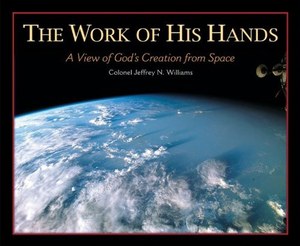Review: The Work of His Handsby Jeff Foust
|
| Williams notes several times looking down at lakes and seeing them crisscrossed with the V-shaped wakes of pleasure boats, particularly on holiday weekends. “Somehow, observing this traditional type of recreation provides a boost to your morale as you vicariously participate.” |
Williams spent six months on the station in 2006, much of that time as one of only a two-man crew on the station. (Williams later spent another six months on the station, returning to Earth last March; this book is about his first stay there.) Interspersed with his work performing research and maintenance on the station, he spent time peering down on the Earth and also taking photos of the planet—more than any astronaut had up to that point. That photography, he said, was partially a hobby—a means of maintaining some balance in his work schedule—but also a way “to take advantage of the unique experience and impress the elements of that experience on the memory.”
That photography is at the heart of the book. Williams arranges the photography thematically: lakes and rivers, mountains, cities, agriculture, and more. The images are in some respects familiar—we’ve all seen countless images of the Earth taken from space—but still nonetheless fascinating, particularly in the level of detail that can be seen from orbit. There are also some photos of life on the station, including two spacewalks Williams performed during his stay, one from the Russian portion of the station and one from US portion.
Of particular interest is the role observing the Earth can play in maintaining morale on a long mission. Williams notes several times looking down at lakes and seeing them crisscrossed with the V-shaped wakes of pleasure boats, particularly on holiday weekends. “Somehow, observing this traditional type of recreation provides a boost to your morale as you vicariously participate,” he writes. Another thrill was getting to serendipitously observe the brief eruption of a volcano in the Aleutians and communicating that finding to scientists in Alaska.
There is a religious message to the book, although it is not a particularly heavy-handed one. Being in space did not bring him closer to God, he said, but it “intensified my faith” by better appreciating God’s role. Even if you do not share his religious beliefs, you can still enjoy The Work of His Hands for his descriptions of life and work on the ISS and his photography of the Earth, something that can be universally treasured regardless of one’s beliefs.
